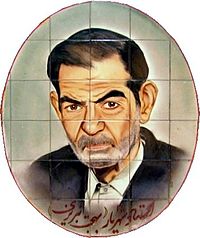Mohammad-Hossein Shahriar
| Seyyed Mohammad Hossein Behjat-Tabrizi (Shahriar) | |
|---|---|
 Shahryar |
|
| Born | 1906 Tabriz, Iran |
| Died | September 18, 1988 Tehran, Iran, (Buried in Maghbaratol Shoara, Persian: مقبرةالشعرا) |
| Occupation | Iranian Poet |
Seyyed Mohammad Hossein Behjat-Tabrizi (Azerbaijani: سيد محمدحسين شهريار, Persian: سيد محمدحسين بهجت تبريزي) (1906-September 18, 1988), chiefly known by his pen name as Shahriar (or Shahryar / Shahriyar شهريار), was a legendary Iranian poet of Azeri origin, wrote in Persian languages and Azerbaijani language.
Biography
Born in Tabriz, Shahriar came to Tehran in 1921 and continued his studies in the Dar-ol-Fonoun high school and started studying medicine after graduation from Dar-ol-Fonoun in 1924. But he fell in love, left his studies about a year before receiving his M.D. degree, and went to Khorasan. He returned to Tehran in 1935 and started working in the Agricultural Bank of Iran.
Shahriar was the first Iranian to write significant poetry in Azerbaijani. He published his first book of poems in 1929, with prefaces by Mohammad Taghi Bahar, Saeed Nafisi, and Pezhman Bakhtiari. His poems are mainly influenced by Hafez. His most famous poem Heydar-Babaya Salam, in Azerbaijani, is considered to be among the best modern poems in the language and has been turned into a few plays.
His most famous Azarbaijani work Heydar Babaya Salam, Published in 1954, won the immense affection of the both the Turkic and Iranian speakers. Heydar Babaya Salam is translated into more than 30 languages all over the world, specially in Turkic speaking countries.
His day of death is named the "national day of poem" in Iran. A television series about his life was directed by Kamal Tabrizi and aired on IRIB channel 2.
Mohammad Hossein Shahriar, was one of the first Iranian Azerbaijani to write a significant collection of poetry in the Azerbaijani language. Born in 1906 in a village near Tabriz, he received his elementary education, including the Divan of Hafez, under his father's supervision. Shahriar’s first formal education was at the Motahari (former Mansoor High School) Secondary School in Tabriz. He subsequently studied at the Darolfonun (former higher education school) in Tehran. Although he studied medicine in college, he dropped out just before getting his diploma and went to Khorasan, where he found a job as a notary public and bank clerk. Initially he published his poems under his given name, Behjat, but later chose the name Shahriar.
Statue of Shahriar in Tabriz
This passionate poet began by composing tragic poetry. Many of his bittersweet memories are reflected in his books Hazyan-e Del, Heydar Baba, and Mumiyai. Heydar Baba, composed in Azerbaijani and later translated into Persian, was for a long time on the top ten best-seller list in Tehran. Heydar Baba is the name of a mountain where the poet spent his childhood. He also wrote a book of epic poems, Takht-e Jamshid.
He was interested in humanistic issues and in his poem "A letter to Einstein" he criticized the result of his scientific work that was abused as nuclear weapon.
Shahriar’s verse takes diverse forms, including lyrics, quatrains, couplets, odes, and elegies. One of his love poems, Hala Chera, was set to music by Rouhollah Khaleghi. The composition for orchestra and solo voice became one of his most well-known works. One of the major reasons for the success of Shahriar’s work is the sincerity of his words. Since he uses slang and colloquial language in the context of poetry, his poems are understandable and effective for a broad segment of the public.
Shahriar was a talented calligrapher, played the setar very well, and had a keen interest in music. He was a very close friend of the Persian musician and highly respected teacher Abdulhossein Saba. He died in 1988.
بؤلوم لر
سون یازیلار
باغلانتی لار
بلاگا گؤره
آرشیو
یولداش لار
